|
Newsletter inside|out - IT news at ETH Zurich (01.03.2018)
 |  |
 |  |
 |  |
 |
 | 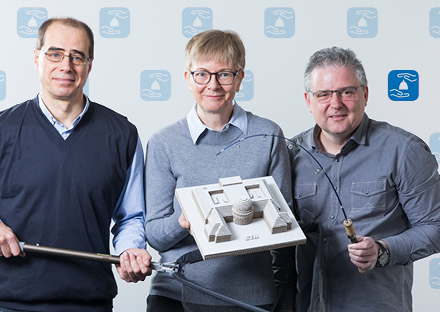 |
| There’ll be no "fishing forays" here – Anatoliy Holinger (ITS NET), Anja Harder (ITS) and Tibor Magoc (ITS BD), from left to right, symbolically protect the ETH model of the Raplab (D-ARCH). A big thank you goes to Daniel Baumann for the ETH scale model. |
IT security at ETH Zurich |
Phishing, ransomware, password theft or processor error: barely a day goes by without the identification of a new "hack" or a new weak spot, and that’s precisely why IT Services have assembled a new security organisation. Security is our highest priority. We have cast our nets, and remain on the ball for you and for ETH Zurich.
Questions we are seeking answers to: How can users be protected from phishing mails? How is secure software developed? How can you safeguard a Linux system? And what about a MacBook or a Windows server? How do you protect user accounts from unauthorised access? How can you recognise successful hacker attacks as quickly as possible? What risk does the current wave of attacks present for ETH Zurich? How do we deal with a security incident?
These sorts of security topics affect us at IT Services on a daily basis, since our customers have to be able to rely on the IT security of our services. In order to counter this challenge, we have been building up the ITS security organisation since 2017. You’ll find more information in the ITS Blog and from Anja Harder, Chief IT Security Officer at IT Services.
Anja Harder, Chief IT Security Officer IT Services
|
|
|  |
 |
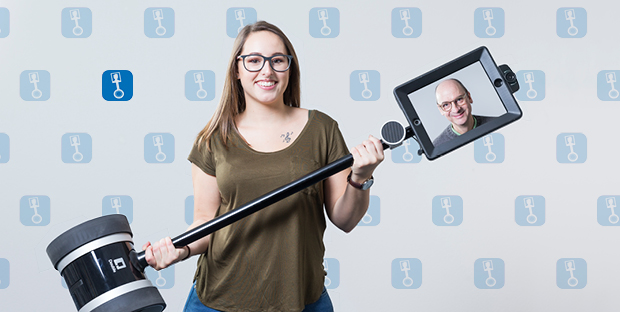 | 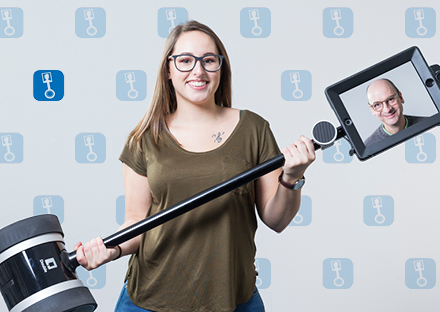 |
| Present and telepresent: Armin Brunner and the "Double", presented by Samira Andreoli, mediamatics trainee at ITS MMS. |
Mobile and present in a remote location |
The latest generation of video conference supplements classic spatial systems and solutions for the workplace with mobile and remote-controlled devices. These facilitate more active arrangements of meetings and more informal communication among participants, and are thus a possible supplement to teleworking and remote cooperation. The multimedia services of IT Services are testing these systems known as "telepresence robots" to see if they are suitable for use at ETH.
Even in this age of robots and drones, the "Double" is a real eyecatcher: a combination of Segway and iPad, it moves seemingly independently through rooms and corridors, with a person’s face on its screen. Its little brother "Kubi" is inconspicuous in comparison, a pedestal that can be controlled remotely in two dimensions and serves as a stand for a tablet, on which a video conference is taking place.
Both devices aim to improve on conventional video conferences by boosting the "presence" of the remote person, on the one hand through the active control from the remote location, which offers genuine mobility with the Double, or at the very least orientation within the room with the Kubi. On the other hand, this mobility means the devices are perceived as "human-like" objects.
Alongside technological suitability, the tests carried out by Multimedia Services will primarily examine whether greater presence can be achieved and what applications within the university sphere can benefit from this; interested persons are indeed welcome to sign up to borrow one. More information can be found in the ITS Blog.
Armin Brunner, Head of Multimedia Services (ITS MMS)
|
|
|  |
 |
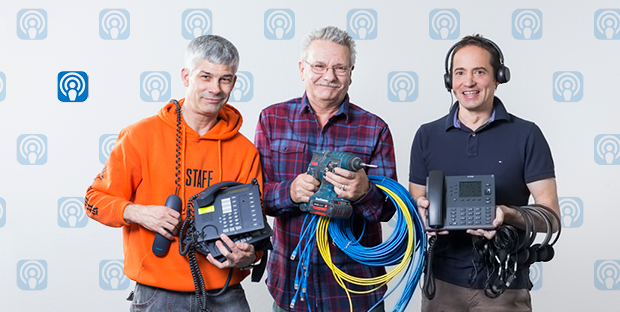 | 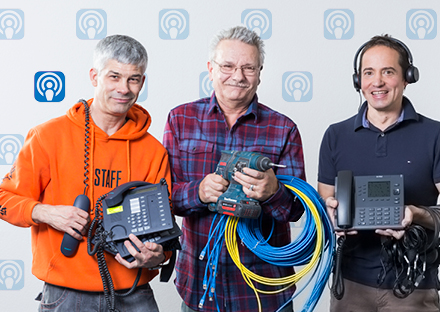 |
| Farewell old telephones – welcome new telecommunication: Cyrille Voélin, Peter Schmid and Thomas Fankhauser (from left to right, all ITS NET) are ready with the drill for the installation of the UCC service among employees. |
UCC: Ready for the next step? |
Some people can hardly wait to benefit from the new possibilities. Others, however, are asking themselves whether they will be able to use the new communication options and what the new service will do for them, or they believe that their normal desktop phone is entirely sufficient. The rollout of the new UCC solutions means for the IT Services not only to conquer logistic and technical hurdles, but also the elimination of psychological reservations. It’s therefore very important to ITS that the advantages are highlighted and employees guided in the switch to UCC.
The last technological hurdles from the UCC pilot operation have been resolved and everything is ready for the blanket rollout – an enormous technological and logistical effort. We’re talking about 180 buildings and even more organisational units, some with different generations of telephone systems. It’s therefore not enough just to install software on the chosen communication devices (workstation computer or mobile devices) and to migrate the telephone numbers to the new solution on the appointed day. Rather, the switch to UCC means that thousands of old telephone appliances need to be removed or, where appropriate (meeting rooms, corridors, laboratories), replaced. Headsets also have to be provided for the new communication options and software distribution organised.
Alongside the technology, we are explaining the new possibilities and coordinating the switch with the affected employees and groups. We help with the mental adjustment "from calling using a desktop phone to communicating with a headset and PC". If you have already made the switch and are satisfied with the new UCC solution, you can support us by telling people in your area about UCC and showing them the benefits. You can follow the progress of the rollout at any time on the UCC service site.
Pius Baumann, Group Manager Unified Communication and Collaboration (ITS NET)
|
|
|  |
|
|